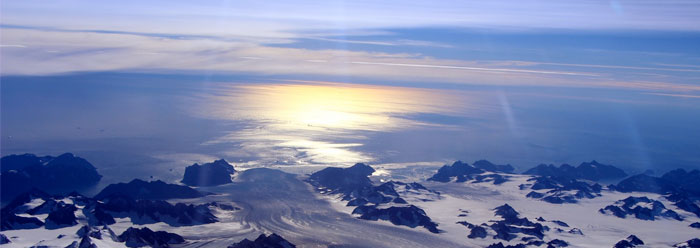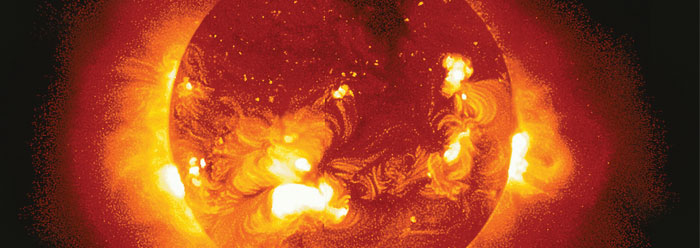Secular speculations insist Earth coalesced into its current state over four billion years ago, leaving one huge problem: the young sun would have been so dim that Earth would have frozen. Secular astronomers have long invoked methane gas to defray this dilemma, called the "faint young sun paradox." A recent study revealed two new reasons to totally reject methane as a rescuing device, leaving this paradox stronger than ever.
According to a University of California Riverside (UCR) news release, "For at least a billion years of the distant past, planet Earth should have been frozen over but wasn't."1 Life forms that left fossils fitted to these "ages" clearly show that Earth wasn't frozen, but perfectly suited for life from the time of its earliest rock deposits. A methane-packed atmosphere might have generated enough of a greenhouse effect to insulate the planet for life to survive those long ages.
Publishing in the journal Proceedings of the National Academy of Sciences, three researchers associated with the NASA Astrobiology Institute revealed a key oversight that decades-worth of methane-embracing models apparently overlooked.2 Their new and more realistic model of biogeochemical cycles in an early Earth's oceans revealed plenty of methane-destroying sulfate.
Lead author of the study and UCR graduate student Stephanie Olson told UCR Today, "You can't get significant methane out of the ocean once there is sulfate."1
Without oxygen, Earth would have no ozone to shield even a faint sun's UV radiation. Radiation slaughters methane molecules and damages DNA. Since life thrived when currently fossilized creatures roamed Earth, oxygen was certainly around at the time.
But that means oxidation reactions occurred. On continents, these reactions would have turned iron into rust and pyrite into sulfate. Erosion would have transported loads of sulfate to oceans, where even a smidgeon of it would directly destroy methane. And insufficient methane in the oceans means too little methane for the atmosphere to warm things up.
UCR wrote that this study revealed "that during the billion years they assessed, sulfate in the ocean limited atmospheric methane to only 1 to 10 parts per million—a tiny fraction of the copious 300 parts per million touted by some previous models."1
At least 300 parts of methane per million parts of other gases might rescue an early-Earth scenario from the faint young sun paradox. But 10 parts per million falls woefully short. However, this analysis revealed a second reason to reject the idea that methane could rescue an early Earth from freezing over.
Single-celled marine life was around back then, supposedly making all the methane. But in today's oceans, tiny cells extract energy much more efficiently from sulfate than by processing complex organics to make methane.3 Ancient cells would have preferred sulfate and produced too little methane.
Methane to the rescue? Not anymore, according to this recent secular science.
Over the years, researchers described an array of scenarios to salvage the faint young sun paradox, but none satisfy. A 2012 study imagined the existence of an ancient solar wind that flowed about 1,000 times faster than observed today, enough to warm Earth.4 But that scenario would merely replace the faint young sun paradox with equally vexing questions. What would have caused the sun to break wind with just the right force for just the right duration to keep Earth at just the right temperature for just the right time for life to survive?
The faint young sun paradox's dogged persistence reveals a fundamental misstep. Instead of tossing up extremely unlikely or impossible Earth-based or sun-centered scenarios to explain a billion years of Earth history, why not question the billion years? A recently created Earth suffers no such painful paradox.
References
- Nealon, S. Methane Muted: How Did Early Earth Stay Warm? UCR Today. Posted on ucrtoday.ucr.edu September 26, 2016, accessed October 8, 2016.
- Olson, S., C. T. Reinhard, and T. W. Lyons. 2016. Limited role for methane in the mid-Proterozoic Greenhouse. Proceedings of the National Academy of Sciences. 113 (41): 11447-11452.
- Deppenmeier, U. 2002. The unique biochemistry of methanogenesis. Progress in Nucleic Acid Research and Molecular Biology. 71: 223-283.
- Schirber, M. "Baby Fat" on the Young Sun? Astrobiology Magazine News. Posted on astrobio.net February 13, 2012, accessed October 11, 2016.
Image credit: © NASA. Adapted for use in accordance with federal copyright (fair use doctrine) law. Usage by ICR does not imply endorsement of copyright holders.
*Mr. Thomas is Science Writer at the Institute for Creation Research.
Article posted on October 24, 2016.























